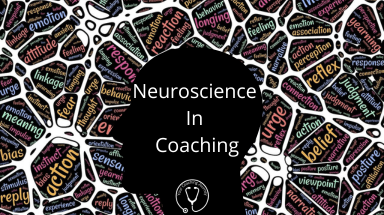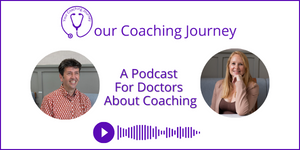Firstly, just to be clear, we are not neuroscientists!
However, we do know that having some awareness of key elements of neuroscience can help us to support our clients well. And it’s one of the topics that we do explore on our transformational coaching diploma.
What is neuroscience?
Neuroscience is the scientific study of the nervous system, including the brain. It’s about understanding neurons and neural circuits. It encompasses a number of different disciplines, including:
- Cytology – the study of cells.
- Neurology – the study of nerves.
- Hodology – the study of connections
There’s also specialist areas like anatomy, physiology, molecular biology, developmental biology, social neuroscience, which also introduces things like social and behavioural sciences, that all need to be considered in relation to neuroscience. That’s a lot of ground to cover.
What is neuroscience in coaching?
When we talk about neuroscience in coaching, we’re talking about areas of neuroscience that might be interesting to explore within coaching. If we have an awareness of neuroscience theory, that can help us to understand:
- our coachees motivations
- decision making processes
- some aspects of our clients social reactions, including their stress responses,
- how their brains deal with change, understand their emotional responses to situations. It might help us to some neurodiversity for different clients coming to us,
- and possibly the neuroplasticity of our brains and how we can create new neural connexions,
- stress responses
All of those things can be really useful in the coaching room. They can help us to support our coachees to:
- use strategies to feel motivated,
- make good choices,
- navigate their social world with an awareness of what might provoke a stress or a reward response in social situations,
- engage with change in ways that are helpful for them
- understand and manage their emotional reactions
- understand and manage stress responses
- think about and explore their thinking,
- think about and explore their behaviour,
- think about and explore their habits,
This all goes on in the brain. So having this awareness is going to really help us as coaches.
Where would be a good place to start in thinking about neuroscience in coaching?
A great place to start with neuroscience is recognising that as humans, our brain and our nervous system are both incredibly complex and they allow us to do extraordinary things that no other creatures on earth can do. And at the same time, they’re terribly flawed and full of inconsistencies and idiosyncrasies that mean both our hardware and our software are a bit faulty. I think, if we’d bought an AI version of us, we’d probably send it back, because it’s not logical all of the time, is it?
There is a lot of information for our nervous system to process and interpret, then act upon:
- Information through our senses: sight, hearing, touch, smell and taste
- What we sense through interoception: knowing how something feels within our body.
- What we sense though proprioception: knowing how our body is moving and where it is in space around us.
- How we feel: tired, stressed, pain, , discomfort, energised, confidence, anticipation
- Emotions that come up
And then added on top of that, we have our memories, and our memories are particularly tricky for us because we all have them, but we don’t necessarily know whether they are accurate or not. And particularly with emotional memories, we will have really strong emotional memories, but they can be really flawed because at the time that those strong emotional memories are created, we might be suffering from a stress response, which means we don’t see the world perhaps, as it is. We’re not quite as logical in those moments, but we remember them really well.
Plus, much like we mention in our exploration of Cognitive Behavioural Coaching, we’ve got all these filters which we have developed or learned including our values, beliefs, and past experiences. All of these are interlinked with all of the other things that you’ve just mentioned.
And then on top of that, we have our drives, these strong drivers that sit underneath emotions, that are actually connected to our needs. Hunger, comfort, connection, reproduction, all of those needs that sit there, that create drivers that aren’t actually emotional, but they’re there anyway. That’s another layer of complexity.
And, of course, we have our hormones and how our hormones impact on us.
It’s very complex.
We’ve got all this complexity housed in a very primal body that works in an animalistic way, and on top of that we have our evolved thinking, which again is flawed, but that adds multiple levels of complexity.
We also know now, through neuroscience research that we have neuroplasticity, which is that idea that our neural connections are changing all the time and the brain is changing. During adolescence it’s changing the most. But throughout our lives, we’re quite capable of changing the neural connections and learning something new. We have a lot of coachees that might come to us and say they are too old to learn something new or do things differently. But what we know is that those neural connections can be strengthened, and we can find new pathways to doing new things and create new muscle memory*.
*When we say muscle memory, a phrase a lot of people use, what we actually mean is neural memory, it’s a neural pathway.
We’re creating those new neural connections in our brain that allow us to do things without us thinking too much about it. If we weren’t aware of that concept of neuroplasticity, we might agree with someone who says they’re too old to learn something new. But of course, through research we know that’s not the case.
There’s an awful lot going on in neuroscience that isn’t the neuroscience of coaching, but the awareness of these things can really enrich our coaching if we stop to think about it and study it a little bit.
What research is there that’s relevant to coaching?
There’s actually very little neuroscience research that’s been conducted around the activity of coaching. There’s only a couple very small studies by Richard Boyazis and Anthony Jack that involve any sort of fMRI scanning and they weren’t doing the scanning whilst people were being coached. It’s related to coaching, but it’s not actually a neuroscience study on coaching.
About 66 people were involved in the studies. The first study they did involved people having some coaching, two different methods of coaching. One was coaching for what they call compliance, focussing on the challenges the participants faced in meeting expectations currently placed on them. And the other one was around visualising their ideal life in the future. And then a week later they put them into an fMRI scanner and prompted them with statements around each of those things that reminded them of their coaching. They then looked at the brain imaging that came from that. They found that the coaching for compliance participants had greater activity in the area of the brain related to the sympathetic stress response, whereas the group looking at their future had more activity in the areas related to visual imagining, motivation and the parasympathetic response (stress modulation).
It was a very small study, but I think it does back up what we tend to think of as good coaching practise. That for us is the idea that we stop to think about a future vision and we get people to think about their desired future, how they want to be in the future, rather than, okay, what’s the problem you’re having now? How are you going to overcome it? How are you going to get there faster?
It tells us that we want to keep people in a good place and to be doing some creative thinking, some generative thinking and visualising. This links in with nicely with our blog and podcast about goals and our idea that coaching is more than goals.
How can we use neuroscience in the coaching room?
If we’re coaching for compliance, around problems and challenges and how our client might overcome them, they may have a stress reaction or start to feel uneasy, and that’s not what we want people to do in the coaching room. We want to be encouraging and get them to do some new thinking.
When it comes to taking action, there might be a little bit of discomfort but we want to keep them in a good place. So I think the research that Boyatsis and Jack have done does back up the fact that if, as we work as a coach, we can keep people safe and in that space of generating new thinking, we’re going to do good work. If we push them in terms of speed and efficiency, then that’s probably not going to be effective coaching.
It’s also useful to be aware of the work of David Rock, which has been around for a good ten years now. David Rock came up with a concept called SCARF, which is a model that looks at the social interactions that we have. And he uses the work of neuroscientists like Naomi Eisenberger, Matthew Lieberman, and Evan Gordon, who all do social neuroscience (essentially, that’s looking at our reactions to what’s going on in the world). David Rock would suggest that we look to maximise the reward and we minimise the threat in social settings. So if you’re coaching someone and it has anything to do with other people and they’re struggling, it would definitely be worth exploring the SCARF model. We have a blog and podcast episode on this topic so that’s a good place to start.
If you’d really like to learn how to utilise these ideas and models to help facilitate long term change or new thinking for others, you can find out more about our Transformational Coaching Diploma here.



